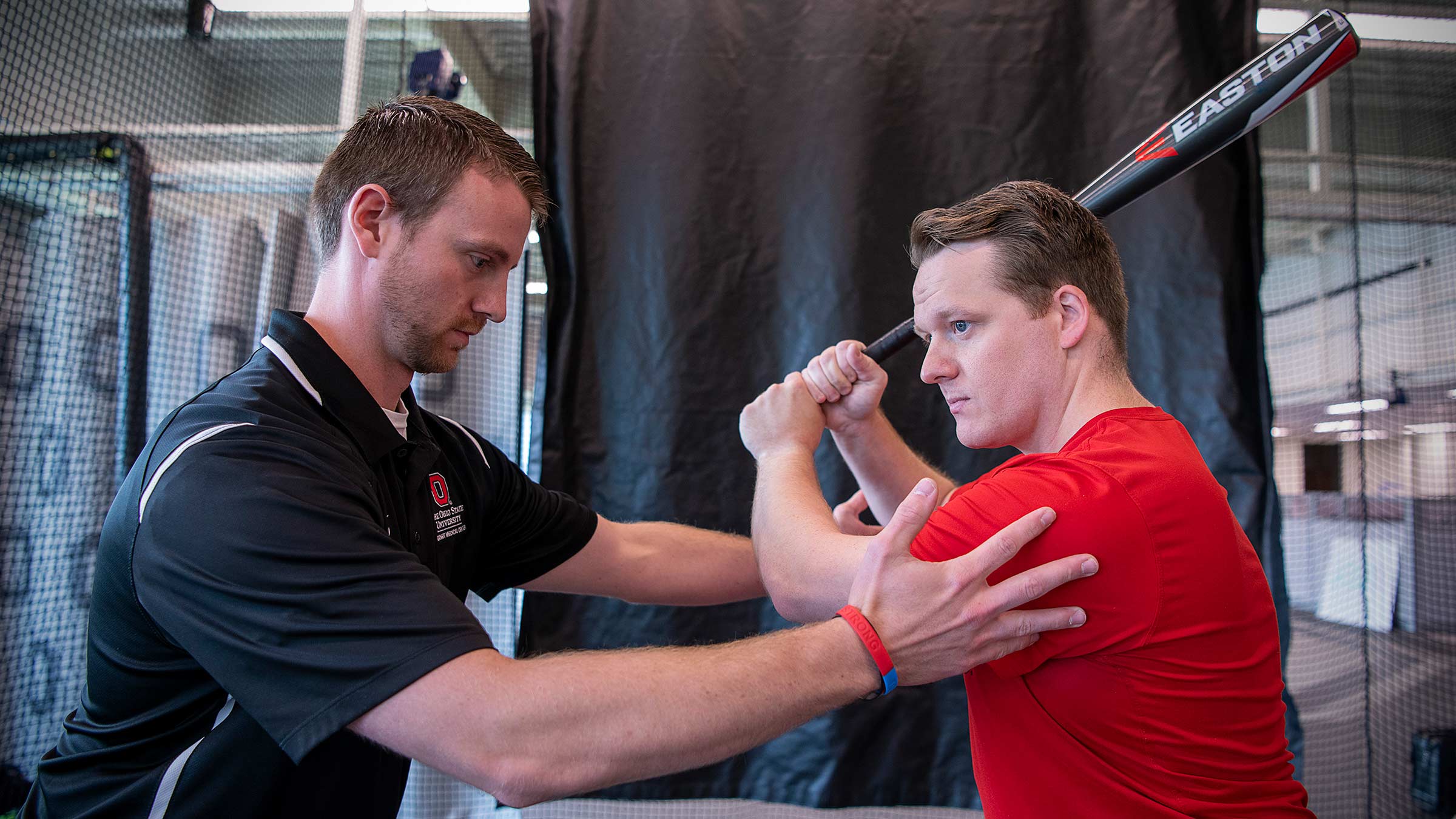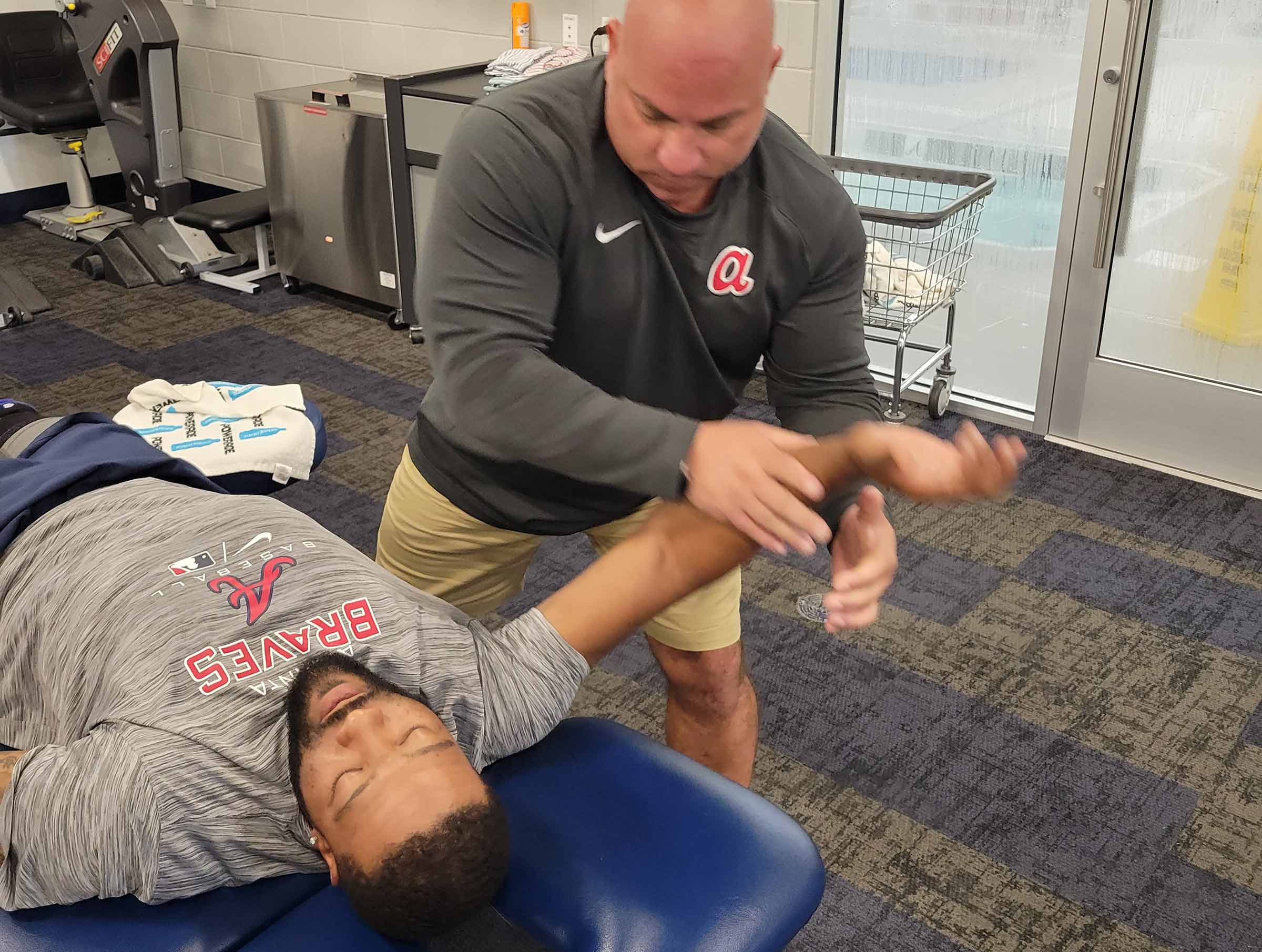Physical therapists fast-tracked to baseball’s big leagues via specialized training program

Baseball, often referred to as America’s pastime, is anything but a walk in the park. In addition to exceptional skills, the game requires intense mental and physical toughness. The effortless pitches, home runs and stolen bases that exhilarate crowds are the result of hours of training by athletes and interdisciplinary collaboration between coaches, athletic trainers and health care professionals — the medical team behind the game of baseball.
Physical therapists are at the core of this highly integrative profession. They actively work behind the scenes to advance the game of baseball, using science to ensure optimal player performance.
A unique training program that originated at Ohio State is preparing physical therapists with the advanced training they need to step into the big leagues and take on coveted medical careers in Major League Baseball.
Throughout the School of Health and Rehabilitation Sciences’ 12-month Upper Extremity Athlete Fellowship program, physical therapists actively integrate curriculum-based knowledge into practice to ensure comprehensive care of professional athletes. As a result, Ohio State-trained fellows are entering professional baseball as experienced health care professionals and skilled interdisciplinary team members.
John Dewitt, DPT, PT, AT, associate director of Education and Professional Development, oversees the Physical and Occupational Therapy Residency and Fellowship Programs at The Ohio State University Wexner Medical Center and School of Health and Rehabilitation Sciences. He played a critical role in the development of this fellowship program.
“Nationally, our program was the first accredited Upper Extremity Athlete Physical Therapy Fellowship,” Dr. Dewitt says. “We laid the groundwork for many other programs.”
Dr. Dewitt says the structured curriculum and clinical mentorship made this fellowship the first of its kind, setting up graduates to work directly in their field of interest: professional baseball.
Greg Hock, DPT, PT, serves as the fellowship program director and team lead of Clinical Operations at the Ohio State Jameson Crane Sports Medicine Institute. He explains why physical therapists are critical in professional baseball.
“The throwing motion itself is one of the fastest and most aggressive motions that we do as humans,” Dr. Hock says. “The rotational speed at the shoulder joint can be as fast as 7,000 degrees per second.”
Due to the repetitive nature of baseball mechanics, overuse injuries are common in the shoulder and elbow for these elite athletes. This is where physical therapists come into action. They provide care on the field and develop long-term recovery programs for each professional athlete.

The Ohio State training program prepares graduates to examine, diagnose and treat injuries of the upper extremities while holistically addressing player-specific problems using biomechanical techniques, or movement-focused injury prevention. The fellowship program, established in 2014, ensures that students receive hands-on training through a collaborative partnership between the MLB Cleveland Guardians and Ohio State Sports Medicine.
Fellows participate in diverse learning opportunities including faculty mentorship during clinical practice, open discussions on their learning experience and opportunities to shadow physicians. Throughout the spring and summer, the fellows work with a professional baseball team.
Typically, one physical therapist per year gains acceptance into the fellowship. This year’s round of applications nearly doubled as the program’s reputation and esteem grows.
Daniel Himmerick is a graduate of the program who now works as a physical therapist with the Cleveland Guardians.
“The fellowship provided the education, both clinically and professionally, to advance my skills and learn to work well within a team environment,” Himmerick says.
These skills involve more than the clinical application of knowledge — they involve interdisciplinary communication.
“I collaborate with multiple performance team members to design each athlete’s rehabilitation program, which in turn brings us closer together as a medical staff,” Himmerick says.
 As a part of the fellowship, Himmerick (pictured) worked with the Cleveland Guardians during spring training and the Columbus Clippers, the Triple-A affiliate of the Cleveland Guardians, during their summer season — placing him in the perfect position to practice physical therapy in professional baseball.
As a part of the fellowship, Himmerick (pictured) worked with the Cleveland Guardians during spring training and the Columbus Clippers, the Triple-A affiliate of the Cleveland Guardians, during their summer season — placing him in the perfect position to practice physical therapy in professional baseball.
“Many applicants are looking for a guided program to collaborate with experts in upper extremity athlete rehabilitation to develop knowledge and skills unique to this population,” Dr. Dewitt says. “Our fellowship opens the door to professional baseball experience, providing a hard-to-come-by experience many teams are looking for.”
Jeremy Harris (pictured), a physical therapist for the Cleveland Guardians, says the Upper Extremity Fellowship was transformational in his development.
“The minute I walked into the door at the Crane (Sports Medicine Institute), it was an opportunity to build on what I knew,” Harris says. “I was a blank canvas and this program contributed to putting the pieces together.”
As the program director, Dr. Hock is engaged in further developing the curriculum and building professional connections integral to preparing each fellow for their role as a physical therapist in professional baseball.
“It goes back to the program structure. The time they get to spend in spring training and the summer season incorporates many components that go with a professional sport,” Dr. Hock says.
Harris agrees with the importance of the real-world, practical application afforded by the program.
“Everything came full circle during spring training in Arizona and working with the Triple-A team in Columbus that summer. There was clinically based mentorship, player-based decisions and team development. You could see the linear consistencies in patient cases that still resonate with me today.”
Not only are these fellows well-trained clinicians, but they’re also prepared to work directly with professional baseball athletes.
“The robust curriculum we go through in the fellowship prepares us for the mental and physical challenges this position requires,” says Johnny Passarelli, MPT, SCS, a minor league physical therapist associated with the Atlanta Braves. “The experience and time provided with the Cleveland Guardians as part of the curriculum was vital to the overall development of my learning and hands-on experience that’s required to attain a position in professional baseball.

“I was introduced to the Atlanta Braves through a mentor and faculty of the Upper Extremity Fellowship,” Passarelli says. “This position wasn’t posted online or on any job sites. They selectively recruited for applicants through their network of colleagues.”
Once he became a physical therapist with the Atlanta Braves, Passarelli began integrating performance analytics, one of the foundational training aspects taught as part of the Upper Extremity Fellowship. Performance analytics is an evaluation tool in which a player’s metrics are compared with baseline numbers to determine their highest performing level.
Dr. Dewitt says performance analytics is changing the game of baseball and developing this skill set is central to Ohio State’s innovative program. To date, the program boasts six graduates and faculty members who are working for several professional teams, providing them the opportunity to unite their love for baseball with their career.
“More and more teams are asking about the benefits of partnering with a fellowship program which speaks to the need and demand,” Dr. Dewitt says. “We are committed to our partnerships and working with colleagues around the country to use our program as a blueprint for success.”

Great careers in health care start here
The Ohio State University School of Health and Rehabilitation Sciences has a variety of degree programs designed to meet the growing career needs of today's health care industry.
Get started



